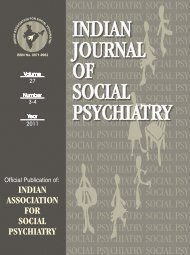IJSP-2010(3-4) - Indian Association For Social Psychiatry
IJSP-2010(3-4) - Indian Association For Social Psychiatry
IJSP-2010(3-4) - Indian Association For Social Psychiatry
Create successful ePaper yourself
Turn your PDF publications into a flip-book with our unique Google optimized e-Paper software.
the national and expanded district programmes. The<br />
movement towards specialization has also eroded the<br />
standing of general and family practice. The community<br />
psychiatry movement was led in the 1970s and 1980s by many<br />
national institutes and centers of excellence. The very ideas<br />
of decentralization and empowerment gradually lost ground<br />
and are all but abandoned by these centers, resulting in a<br />
leadership vacuum. The technology to translate psychiatric<br />
research evidence into primary care practice does not exist in<br />
low income countries (Srinivasa Murthy, 2004). While the<br />
programme has ensured wider availability of essential<br />
psychotropic medication, the failure to integrate mental health<br />
care delivery into primary care has resulted in limited impact<br />
on patient services (Jacob, <strong>2010</strong>).<br />
Restrategised NMHP<br />
The proposed budget for the programme in the 11th Plan is<br />
1,000 Crore with more than 400 Crore being allotted to be<br />
utilized only for manpower development at primary,<br />
intermediate and tertiary levels. Programmes have been<br />
conducted for increasing awareness and reducing stigma.<br />
The revised NMHP is also giving tremendous importance to<br />
suicide prevention. According to the plan, the ministry will<br />
give basic mental health training to physicians at the primary<br />
health centers in the villages and block levels. The district<br />
mental health programme (DMHP) has also been started in<br />
325 new districts. Over the last two decades, the NMHP has<br />
managed to overcome certain barriers for effective<br />
implementation including poor funding, limited undergraduate<br />
training in psychiatry, inadequacy of mental health human<br />
resources, limited number of models and their evaluation,<br />
uneven distribution of resources across states, nonimplementation<br />
of the MHA,1987 and privatization of<br />
healthcare in the 1990s (Srinivasa Murthy, 2007). The goals<br />
of NMHP have drifted towards family and community care,<br />
better organization of mental health services in the primary<br />
care and supporting through mental health initiatives rebuilding<br />
of social cohesion, community development, promotion of<br />
mental health and the rights of the persons with mental<br />
disorders.<br />
BEYOND NMHP (1982): PROPOSED MODEL<br />
The proposed model for an integrated mental health model<br />
involves certain principles laid down in the WHO developed<br />
Mental Health Gap Action Programme (WHO, 2008). This<br />
Nizamie & Goyal<br />
should include political commitment, assessment of needs<br />
and resources, development of a policy and legislative<br />
infrastructure, delivery of the programme efficiently, human<br />
resource development, mobilization of financial resources and<br />
strategy for monitoring and evaluation. Government of India<br />
has proposed to make an India-Australia Advisory Committee<br />
(IAAC) in order to restrategise feasibility and application of a<br />
new mental health programme consisting of representatives<br />
from Director General of Health Services (DGHS), National<br />
Institute of Health and Family Welfare (NIHFW), Central<br />
Government institutes (including NIMHANS, Bengaluru; AIIMS,<br />
New Delhi, CIP, Ranchi and others), Asia Australia Mental<br />
Health and its partners for the development of community<br />
mental health models. The IAAC will focus on capacity building<br />
in 5 parallel streams: facilitating community partnerships;<br />
mental health policy; developing best-practice models;<br />
workforce training and monitoring and evaluation. Certain<br />
issues require attention and concern of the policy makers and<br />
service providers, which are essential in achieving the goals<br />
of the NMHP with maximum efficiency:<br />
• Collaboration with various stakeholders as there is a<br />
greater need for the stakeholders (families, community<br />
groups, human rights activists, etc.) to join hands in<br />
view of the multi-sectoral nature of mental health.<br />
• To develop and modify the current models of service<br />
organization to integrate services into general health<br />
service provision at the primary health care level (apart<br />
from DMHP, integrated approach with other health<br />
programmes eg., collaborating child psychiatry<br />
services with Integrated Community Developmental<br />
Scheme (ICDS), Reproductive and Child Health (RCH)<br />
and neuropsychiatric services with epilepsy prevention<br />
programmes, etc. for better penetration and efficiency<br />
with limited resources and manpower).<br />
• To develop modules for early detection and<br />
intervention. One example includes the life skills<br />
education programmes for school children. Similarly,<br />
psychosocial care of survivors of disasters should be<br />
part of all relief, rehabilitation, reconstruction and<br />
reconciliation programmes, following man-made and<br />
natural disasters.<br />
© <strong>2010</strong> <strong>Indian</strong> <strong>Association</strong> for <strong>Social</strong> <strong>Psychiatry</strong><br />
81



